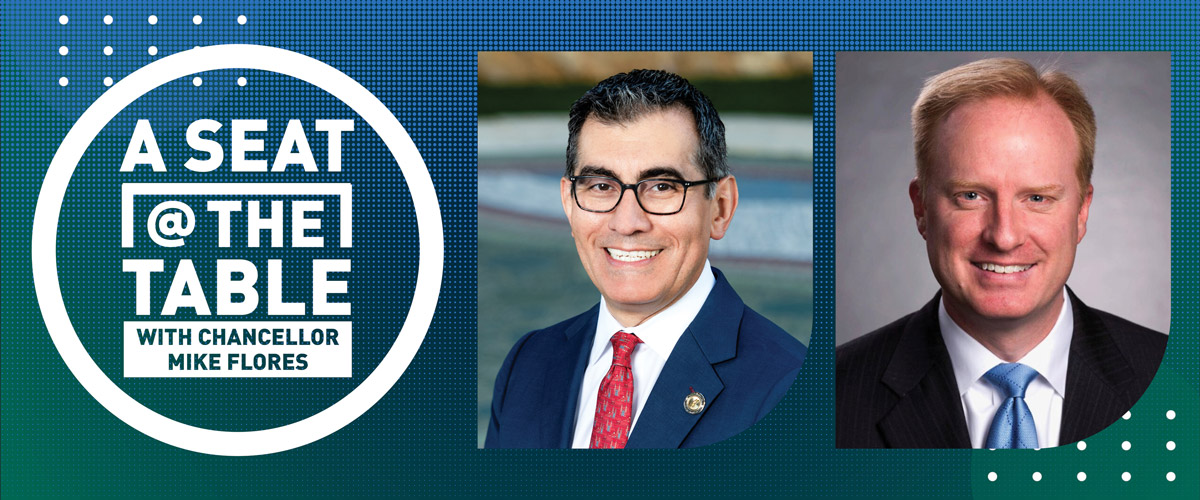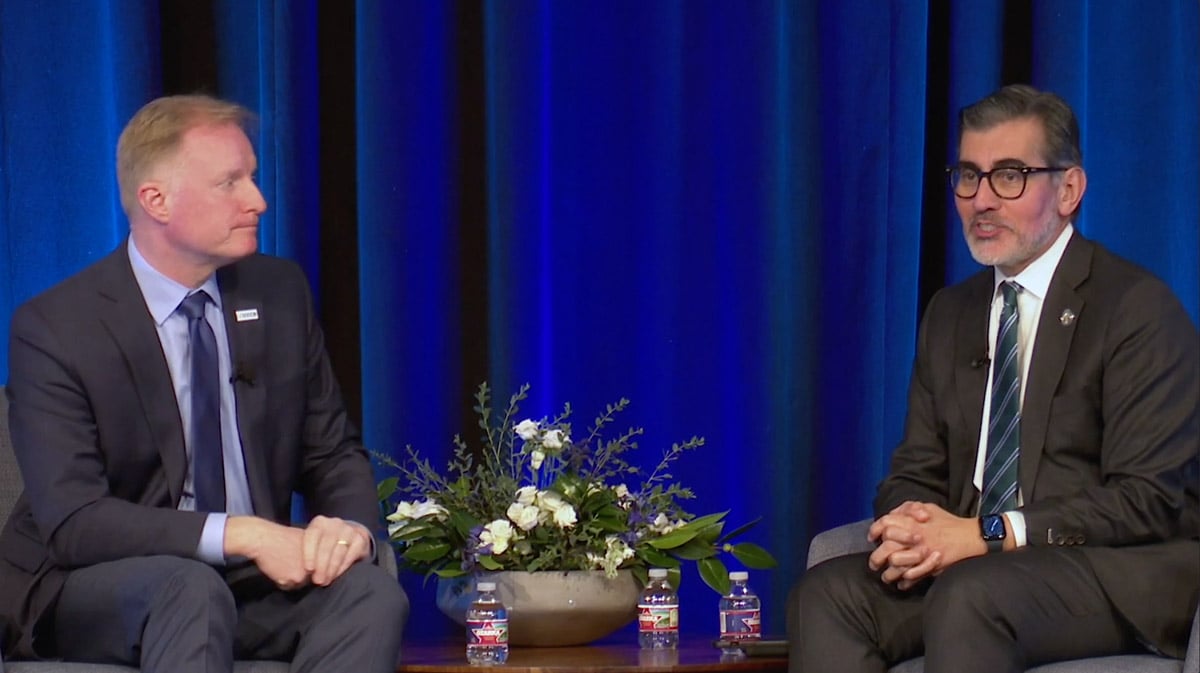Expanding the Texas Talent Pipeline: A Conversation with Dr. Harrison Keller


Expanding the Texas Talent Pipeline: A Conversation with Dr. Harrison Keller
Dr. Harrison Keller, Commissioner of Higher Education, is a sixth-generation Texan with nearly twenty-five years of experience in state budget and policy, university administration, fundraising, and building coalitions among higher education institutions, school districts, and policymakers.
Dr. Keller recently took part in a special edition of A Seat at the Table with Chancellor Dr. Mike Flores to speak about collaborative efforts to expand the Texas talent pipeline and the significance of House Bill 8—a $683 million investment in community colleges aimed at rewarding schools for aiding students in completing their degrees or certificates.
Some key concepts covered during this episode include:
-
How the Building a Talent Strong Texas Plan aims to award valuable credentials to Texans
-
The impact of House Bill 8
-
Future Focus on Collaboration and Workforce
INTERVIEW HIGHLIGHTS
How the Building a Talent Strong Texas Plan aims to award valuable credentials to Texans
Dr. Keller: So first, Chancellor, I just want to say how much I appreciate the opportunity to be here. We are so proud of the work that you and your team are doing at the Alamo Colleges. . and the accolades that are well-deserved. So of course, it’s fantastic to be here to talk about House Bill 8. I do think it’s important to ground the discussion in the Talent Strong Texas work. So I became Commissioner a little over four years ago. Actually, in my last job interview with Governor Abbott, one of the things that I told him is that we’d been with our state’s previous plan for higher education, which was called 60x30 Texas for a few years. Frankly, I didn’t see that it was driving a lot of decisions at the Capitol, sometimes even within institutions, and I thought we needed to rethink the plan.
So I had about four or five months on the job, and then, of course, COVID hit. You and I came in similar times, and then it turned out these weren’t the jobs we thought we signed up for, but the need to update our state’s goals became even more urgent during the pandemic because what we saw is our economy was accelerating in directions that we didn’t anticipate, and things were happening faster than employers expected. We had hundreds of thousands of Texans who were out of work and sometimes needed to be reskilled and upskilled just to get a similar job in the same industry. Frankly, we didn’t have the workforce education infrastructure as a state to meet those challenges. So it was even more urgent for us to update our goals.
So we engaged hundreds of community leaders across the state. We polled the Texas public. We worked with policymakers. We distilled all of that into a new plan for Texas called Building a Talent Strong Texas. So that’s got three major pillars. One is we expanded our focus beyond just traditional. The population coming right out of high school into higher education, pay more attention to adult learners as you were talking about a few minutes ago, Chancellor, but we put an important marker down that we didn’t just want to award more credentials.
So I’ve worked in higher education a long time and, of course, we’re good at coming up with new credentials, but we didn’t want to just make up new credentials and claim that we’re making progress. So we put a marker down that we only want to count credentials that are what we call credentials of value, credentials of value in our Texas economy, and they’re credentials of value because Texas employers value them.
Then finally, we brought the research development and innovation mission into our plan. Our previous plan didn’t have anything on research and development. That plan ended up being really important for guiding our work on community college finance, guiding our work with the universities on research and development, and also guiding our work on student financial aid. So I think that was an important precursor to the work that came later where in this last legislative session you saw the legislature really behind this vision for Building A Talent Strong Texas, and we had a historic legislative session for higher education.
The impact of the House Bill 8
Dr. Keller: We did a lot of work in the interim. There was actually a bill in the previous legislative session that set up a state commission, and the Governor gave us some resources for that commission. Also, our Texas philanthropies and national philanthropies got behind that work. So my team and I supported that commission’s work. We had legislators, we had community college leaders, we had members of the public on the commission. We took the deepest dive any state has taken into these issues around community college finance. We examined who’s participating in community colleges, what results are we getting, how is that changing. We also looked at the cost drivers. There were a lot of important contributions that came out of that work that helped shape this new finance system.
The other thing that happened is that the community college leaders across the state, you and your colleagues, Chancellor, really came together and supported the work of the commission. As the recommendations came together, we were able to work closely with community college leaders across the state and other stakeholders to develop a bold new vision for higher education that frankly went a lot farther than I think a lot of the policymakers might’ve expected. So that was only possible because we worked together in partnership, we listened to the different concerns and considerations from the smaller rural colleges, from the fast-growing urban colleges. We took all of that input and it all impacted the recommendations.
What we came back with, essentially, was a recommendation to completely overhaul the whole system, to not just tinker around the margins, but convert our system from where we’d historically just funded community colleges on the basis of seat time, how many students did you have enrolled in different types of courses to now 95% of the state’s funding for community colleges is driven through a new outcome-based formula for production of credentials of value with more if they’re in high demand fields
for students transferring or for students taking 15 hours of dual credit or dual enrollment courses that apply to either academic or workforce credentials.
We weighted those outcomes because we recognized if you have a student who is a low income student, if you have a student who was not college-ready when they were enrolled or we actually found the highest cost drivers being, if you have an adult learner who’s an adult who’s been out of school for a while, they’re going to need additional support to be able to stay on track and be able to complete that credential. Those adjustments are recognized and included in the new formula.
We also, for the smaller and rural colleges, we stabilized their funding with that other 5% of funding to make sure that all of our colleges are going to have a baseline of funding to be able
to support their instruction and operations. So this was really a historic shift in how we fund our community colleges.
The other piece that is especially going to be felt this next fiscal year is the legislature agreed to make the system dynamic. So we had funded community colleges based on the historical data. All the colleges knew how much state funding they were going to get for the next two years. So the formula is we had only divided up the pie more or less depending primarily on how many courses and what types colleges taught. That meant that all the colleges were in competition with each other.
So as you have a college that’s fast growing, they get more of the pie, a college that their enrollments are stable, they may get less funding. Now, that’s gone in the new House Bill 8 finance system. The colleges are just in competition with themselves.
So the idea is to have a dynamic system where there’s particular dollar amounts attached to those outcomes. If the colleges outperform the projections, that means that’s additional funding to the college regardless of what everybody else does.
We sat down with the policymakers, with Lieutenant Governor, the Speaker, the Governor or the key members of the legislature, and we talked about how that could mean that we might need to ask for additional money, we might need a supplemental appropriation to fully fund the outcomes-based formula, and they all agreed that this was a critical investment in the future of Texas. So at the end of the day, overall, if you count student financial aid and the new funding to colleges, it was about a 30% increase in our state funding for community colleges.
Dr. Flores: So this is really a moonshot in itself. It is historic, the statewide investment that is being made in Texas community colleges, and thanks to the leadership and partnership of the Commissioner to bring it home to San Antonio for us. We are the second largest, but, just looking overall at the list, received the highest amount of overall funds. Under the previous legislation, and this is fairly simplistic, there’s more to tease out, but we would’ve just received net new, the previous, which was enrollment and class-driven, about maybe $5 million. Under the new historic legislation, we actually received $25 million, which gave us a net new 20 million to reinvest back in our students.
So it’s historic in that it’s not zero sum. We’re not competing against 49 other community colleges. It’s additive. It’s, I think, important because it’s supporting us for who we serve and how well they do. I think folks may take a step back from something that’s performance-based, but thanks to the success that we’ve had over many years at Alamo Colleges, I think we said bring it on, right?
Dr. Keller: Yeah, and there’s another piece, I think, that would be good to emphasize. Senator Menendez and his colleagues got behind increased support for the students directly and student financial aid. So the other historic investment was historic increases in student financial aid this session. So for students at community colleges, state colleges, our TSTCs, this
put the ... Overall, we’re serving about the same share of eligible students at the two-year institutions as we do for the universities, and what we were just talking about before he left, that puts us in striking distance, hopefully, for this session of getting to full funding for our need-based aid, which would be our number one request as we go into this next legislative session because of those historic investments.
Not only did they put more money into student financial aid, they also let us increase the scope of who can benefit from that to include those short-term workforce programs. So the legislature really got behind the vision outlined in Building A Talent Strong Texas, got behind our colleges, got behind our innovators, and also is getting behind our students to give them the resources
to eliminate financial barriers and help us achieve that vision for Building A Talent Strong Texas.
Future Focus on Collaboration and Workforce
Dr. Keller: So number one, I would say even as the Commissioner of Higher Education, this isn’t really just about higher education. This is about jobs and economic opportunities. It’s about what kind of Texas we want to live in, what kind of communities we want to live in. So again, what’s critical to this work isn’t just to have more people earning credentials. It’s to make sure that those credentials are going to equip people to take advantage of the new jobs being created, of the opportunities that are there in our communities, and we have so much more work to do. So we have nearly 4 million Texans who have some college and no credential. We have more than 2 million Texans who don’t have high school diplomas or equivalencies. So as an aside, I have to say, another provision of House Bill 8 that flew below the radar screen, we’re actually creating a new high school diploma in Texas that’s going to be awarded by community colleges. So I called up Mike Flores and I said- “I need five colleges. I need colleges that could be the leaders in developing and deploying this new high school diploma,” and before I’d finished my pitch, Mike had already said, “We’re in.” So I deeply appreciate the partnership with the Alamo Colleges in designing ... This is an innovative competency- based high school diploma to help those adults who are enrolled in your workforce programs.




